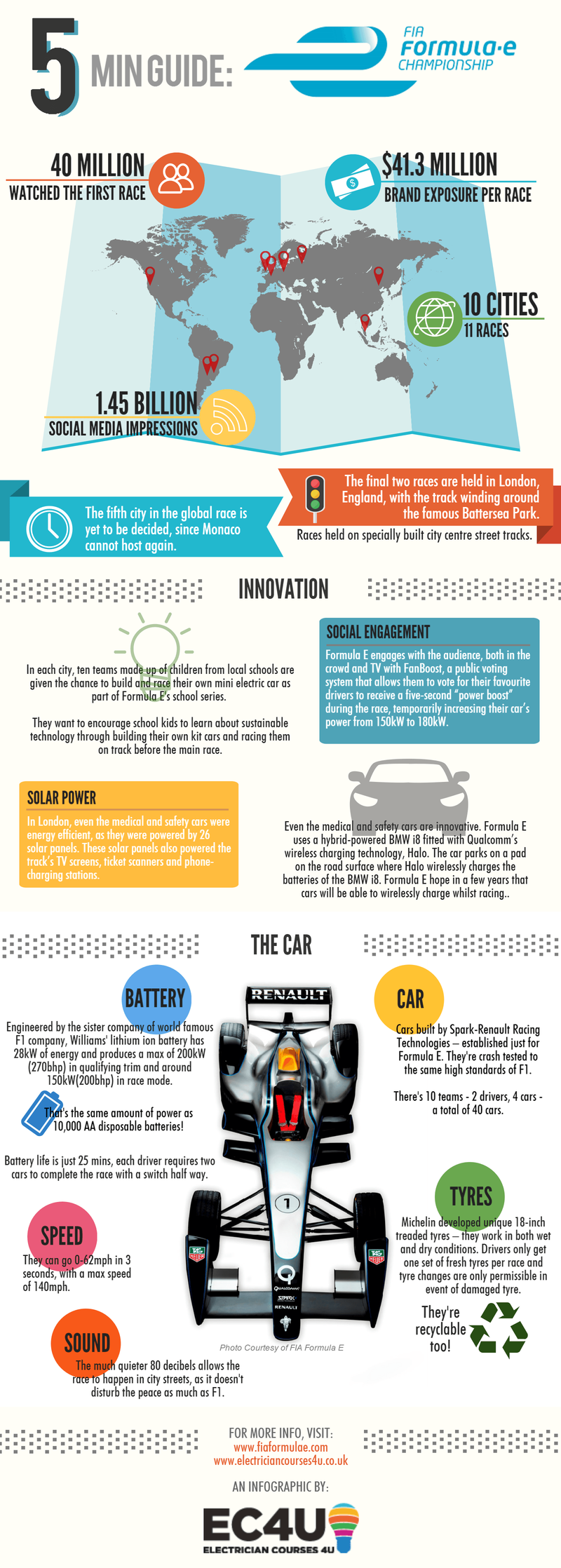Formula E on the rise as 40 million watch first race

With the first season having just been completed in London in June and the second season confirmed, this new global event is still sparking conversation all over the world.
Brazilian driver Nelson Piquet Junior took the title by a single point, in an event where no same driver has won more than three races. VISA sponsors the new event and it’s also backed by the governing body FIA, who have been waiting for the electric motorsport event for years. It’s the only single-seat racing series that steps into the new environmentally friendly world of electrical energy, and it’s already attracted a number of high profile supporters. With the new season beginning in October in Beijing, the future of electric racing looks bright.
A new era of racing
It’s designed to be different and unlike Formula 1, despite many of watchers already comparing it. The public has found it hard to disconnect the two series, despite the differences: electric same model cars, battery operated with speeds of up 140mph and no loud buzzing sound that resonates around the grounds. Sitting at a lower 80 decibels (in comparison to 102+ of an F1 car), these cars sound more like a whirring washing machine, which means they have been able to convince cities to close down their streets for the one-day race.
Formula E has taken a different, unique approach to the racing structure as testing and qualifying take place on the morning of the race, making it more appealing to new fans of the sport that want to give it a go and only need to purchase a single day ticket. In the first season, Formula E took over the streets of Beijing, Miami, Monaco, Berlin, Moscow and London to name a few. This approach brings the hour-long race to the people; it becomes a spectacle for fans and those who have never watched before because of how accessible it is. There’s an essence of street racing to it, with the streets being closed down, music playing everywhere and crowds gathering to watch with excitement. It’s hard to look away from the carefully designed cars when they come zooming round the corner.
What you need to know about Formula E
Three years ago, FIA had a vision of creating a more sustainable motorsport championship, where they could increase the interest in electric cars and further develop technologies. CEO, Alejandro Agag, has invested £60m in Formula E to propel it into mainstream focus. With a successful first season behind them and the second season starting at the end of 2015, they can see the investment only growing. The teams were all given same model cars in the first season – Spark-Renault SRT 01E- but BBC reports that it will become an open challenge next season, allowing teams to build and develop their own cars. The batteries are designed and supplied by Williams Advanced Engineering (the sister company of world renowned F1 company) and each battery has 28KW/h of energy and produces a max of 270bhp in qualifying and 200bhp in race mode. But that is currently not enough energy to complete a race distance and the drivers must change cars halfway through. It is hoped that as years go by, the cars and battery technology will advance to allow them to stay on the track for the full one hour.
The question whether Formula E can inspire motorists to switch to electric cars is the one that emerges after months of Electric racing. Has it won over the crowd with its innovative racing style and sustainable energy power? It’s hard to say if the first season accomplished this, especially with the drivers having to change cars as the battery cannot last the entire race. Formula 1 Red Bull Boss, Christian Horner expressed his opinion on the matter by saying “I’m not sure it’s delivering a great message about sustainable energy, if you’re saying you can’t get to the end of a grand prix or the end of race without having to change cars”.
The future of electric racing
It isn’t about competing with Formula 1, but rather presenting a new form of racing for the modern age. Formula E is paving the way for a form of racing that is energy efficient and environmentally friendly. But whether “it will take over from F1 in terms of people… in four or five years” like Richard Branson believes, is another debate. The two sports are different, despite being governed by the same body, FIA. There’s a huge opportunity with electric racing for new innovative designs for cars, battery and engine suppliers to get stuck into, to design new cars and test new batteries that last the entire race. It will be a true race to see which company can be the first to discover the solution. You never know where a career in electrics could lead you. It could lead you to working on a future season of Formula E, creating the first energy efficient battery to last the entire race.
For this racing company it’s all about following the three E’s: Energy, Environment and Entertainment. Will you be watching the sparks fly when the second season begins in Beijing?
The second season of Formula E starts in October 2015. Join the conversation today with #DriveTheFuture.
Share this Image On Your Site
If you want to know more about the world of electric racing, then read on about the growing demand for electric vehicles!
Back to blog



